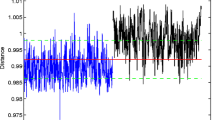Abstract
Although the multi-polarized high resolution range profiles (HRRP) include more target information than single-polarized HRRP, the recognition becomes more difficult because of the huge data and the complex data distribution. Kernel methods based on the multi-polarized HRRPs are proposed in this paper. Two kernel functions based on the multi-polarized HRRPs are first proposed, and then they are employed to the kernel principal component analysis (KPCA) respectively. Finally, the nearest neighbor (1NN) classifier and the support vector machine (SVM) classifier are used to identify the unknown targets. Experimental results based on the simulated multi-polarized HRRPs data show that the proposed methods can raise the correct recognition rate greatly compared with the single-polarized HRRP recognition. Moreover, the computational complexity can be decreased and the recognition performance can be increased to some extent compared with the methods of combination of the single-polarized classifiers.
Preview
Unable to display preview. Download preview PDF.
Similar content being viewed by others
References
Xiao, H.T., Guo, L., Fu, Q.: Radar Target Recognition Method Using Improved Support Vector Machines Based on Polarized HRRPs. In: 2006 International Conference on computational Intelligence and Security, pp. 702–707. IEEE Press, New York (2006)
Radoi, E., Hoeltzener, B., Pellen, F.: Improving the Radar Target Classification Results by Decision Fusion. In: 2003 Proceedings of the International Radar Conference, pp. 162–165. IEEE Press, New York (2003)
Li, H.J., Lane, R.Y.: Utilization of Multiple Polarization Data for Aerospace Target Identification. J. IEEE Transactions on Antenna and Propagation 43, 1436–1440 (1995)
Liu, H.W., Bao, Z.: Radar HRR Profiles Recognition Based on SVM with Power-transformed-correlation Kernel. In: Yin, F.-L., Wang, J., Guo, C. (eds.) ISNN 2004. LNCS, vol. 3173, pp. 531–536. Springer, Heidelberg (2004)
Schölkopf, B., Burges, C.J.C., Smola, A.J.: Nonlinear Component Analysis as a Kernel Eigenvalue Problem. J. Neural Computation 10, 1299–1319 (1998)
András, K., László, T.: Kernel-Based Feature Extraction with a Speech Technology Application. J. IEEE Transactions on Signal Processing 52, 2250–2263 (2004)
Xu, L., Krzyzak, A., Suen, C.Y.: Methods of Combining Multiple Classifiers and Their Applications to Handwriting Recognition. J. IEEE Transactions on System, Man, and Cybernetics 22, 418–435 (1992)
Author information
Authors and Affiliations
Editor information
Editors and Affiliations
Rights and permissions
Copyright information
© 2009 Springer-Verlag Berlin Heidelberg
About this paper
Cite this paper
Li, L., Liu, H., Jiu, B., Wu, S. (2009). Polarization Radar HRRP Recognition Based on Kernel Methods. In: Yu, W., He, H., Zhang, N. (eds) Advances in Neural Networks – ISNN 2009. ISNN 2009. Lecture Notes in Computer Science, vol 5552. Springer, Berlin, Heidelberg. https://doi.org/10.1007/978-3-642-01510-6_35
Download citation
DOI: https://doi.org/10.1007/978-3-642-01510-6_35
Publisher Name: Springer, Berlin, Heidelberg
Print ISBN: 978-3-642-01509-0
Online ISBN: 978-3-642-01510-6
eBook Packages: Computer ScienceComputer Science (R0)




